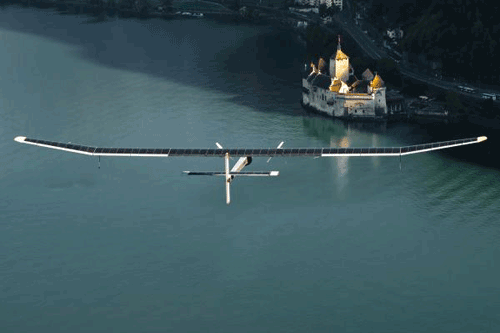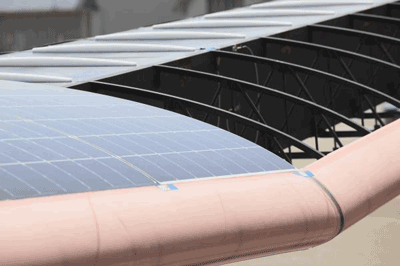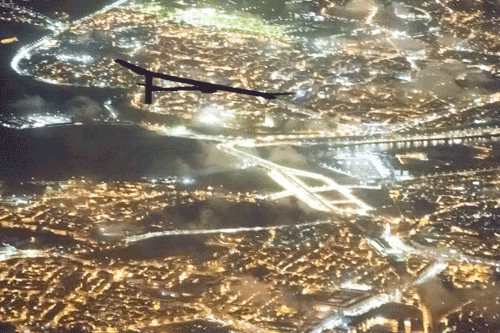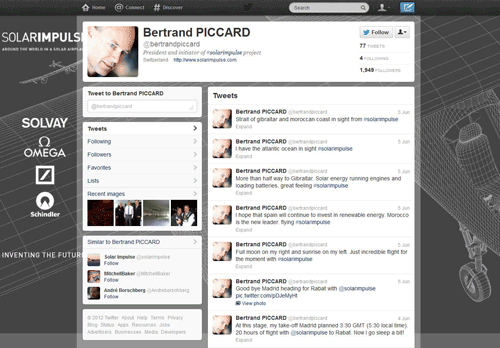Solar plane completes first transcontinental flight sans fuel
It took 20 hours to travel over 515 miles, but plane makes it without using an ounce of fuel
A plane powered entirely by solar energy has successfully completed a flight from Spain to Morocco, the second leg of its journey, as it prepares for a trip around the world.

Solar Impulse in flight. (© Solar Impulse)
The carbon-fiber plane’s wingspan is about the size of an Airbus A340, yet it weighs only as much as a car. It’s powered by 12,000 solar cells which, altogether, turn four electrical motors.

Solar cells and carbon structure of the Solar Impulse’s wing. (© Solar Impulse)
This has been a long time coming — the project was first founded by Bertrand Piccard and André Borschberg in 2003. It is estimated to have cost about $100 million to create. Today, it is supported by a handful of major corporations, including Deutsche Bank, Bayer, and Schindler.
The flight
The single-seat carrier was piloted by Piccard (Borschberg flew the plane’s last leg, which went from Switzerland to Spain). It took off from Madrid-Barajas airport around 5:30 in the morning and then flew non-stop across the countryside and Mediterranean Sea before landing in Rabat, Morocco at the Rabat-Salé international airport at 11:30 in the evening.

Solar Impulse approaches Rabat-Salé. (© Solar Impulse)
That translates to 19 hours and 8 minutes of flight time, and a total distance traveled of 515 miles.
Particularly noteworthy is the fact that when the plane landed, it did so with a full set of batteries. “This is extraordinary, as it represents an increase in confidence in new technologies,” said Borschberg.
This flight marks the first time that the plane landed on another continent. It was also the first time that Piccard piloted the plane. “It was perhaps the most beautiful flight of my life. I have dreamed since I was a child of flying without using fuel,” said a very joyful Piccard, who comes from a family of adventurers, and who has already flown around the world in a balloon.

Bertrand Piccard being interviewed. (© Solar Impulse)
Back in July 2010, the duo made history when the Solar Impulse became the first manned solar plane to complete a 26-hour nonstop flight. Particularly noteworthy was that it proved the sun’s energy was enough to keep the plane in the air, even at night.
Video of landing
Check out the Solar Impulse in flight and its landing in Morocco. Make sure to put the sound on — it’s amazing to hear how quiet the plane is.
Interactive experience
During the course of the flight, fans were able to follow the plane’s flight progress via a virtual Mission Control Center on the Solar Impulse website, which included the plane’s battery status, altitude, and speed.
Piccard also posted live updates via Twitter (@bertrandpiccard). In one of the tweets, he described the “great feeling” he had of gliding across southern European skies with solar-powered engines.

Bertrand Piccard’s Twitter account.
Landing in Morocco
According to Piccard, Morocco’s ambitious solar energy plans were the reason why they chose to land in the country.
“We came here out of admiration for Morocco’s pioneering solar energy program,” he said.
In 2009, Morocco announced a plan to build five solar energy plants that, altogether, will have a capacity of 2,000 MW. The country hopes to have the project completed by 2020. Construction of the first plant, which will be situated in Ouarzazate at the edge of the Sahara Desert, will start this month.
Outlook
Right now, Solar Impulse can only fly in perfect weather. It has gotten as high as 28,000 feet and reached speeds over 75 mph (its cruising speed is approximately 35 to 40 mph).
This most recent mission is being described as a final dress rehearsal before the team’s planned round-the-world flight, set to take place with a new-and-improved plane in 2014. It will have a total of five stops during the flight itself.
The goal with Solar Impulse isn’t necessarily meant to one day replace conventional air travel; rather, Piccard and Borschberg are hoping to demonstrate what is possible with solar energy. “All of the technology on this plane can be used in daily life,” Piccard said.
Learn more at the Solar Impulse website. ■
Advertisement
Learn more about Electronic Products Magazine





